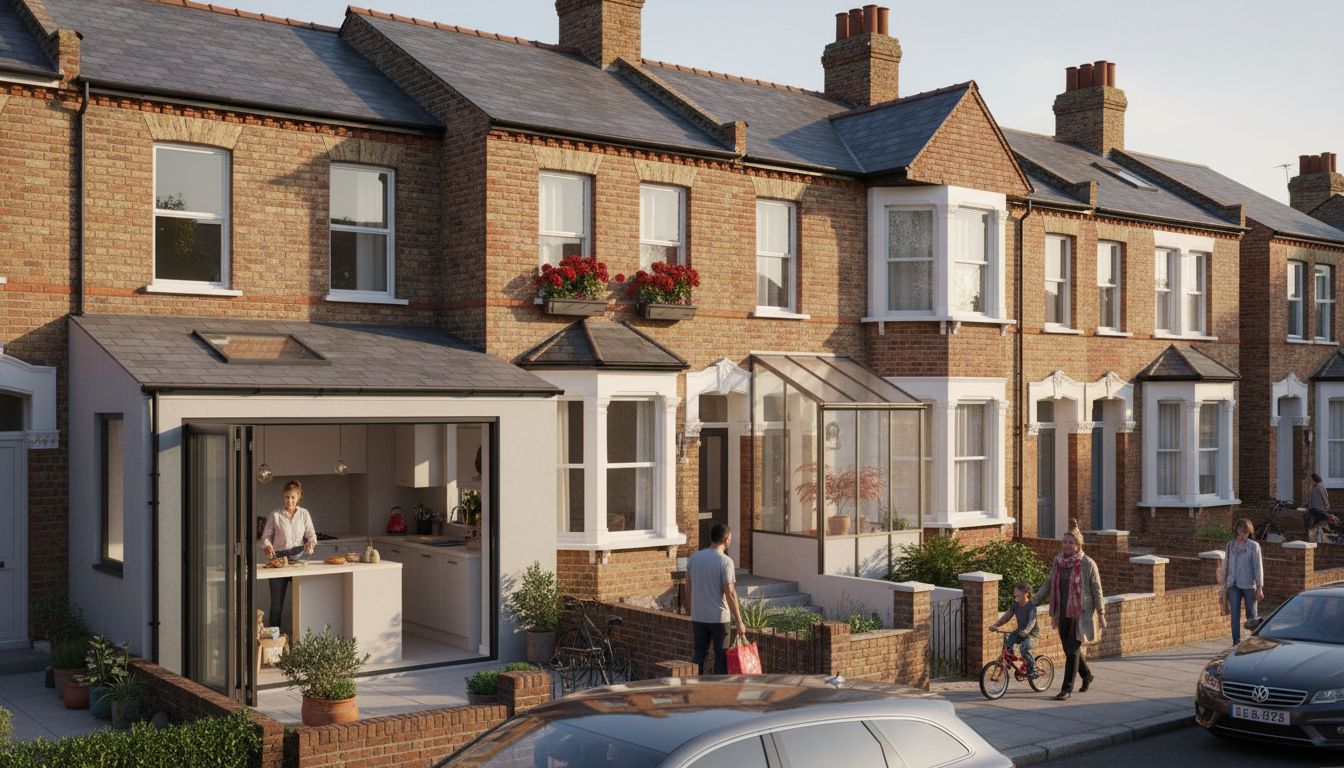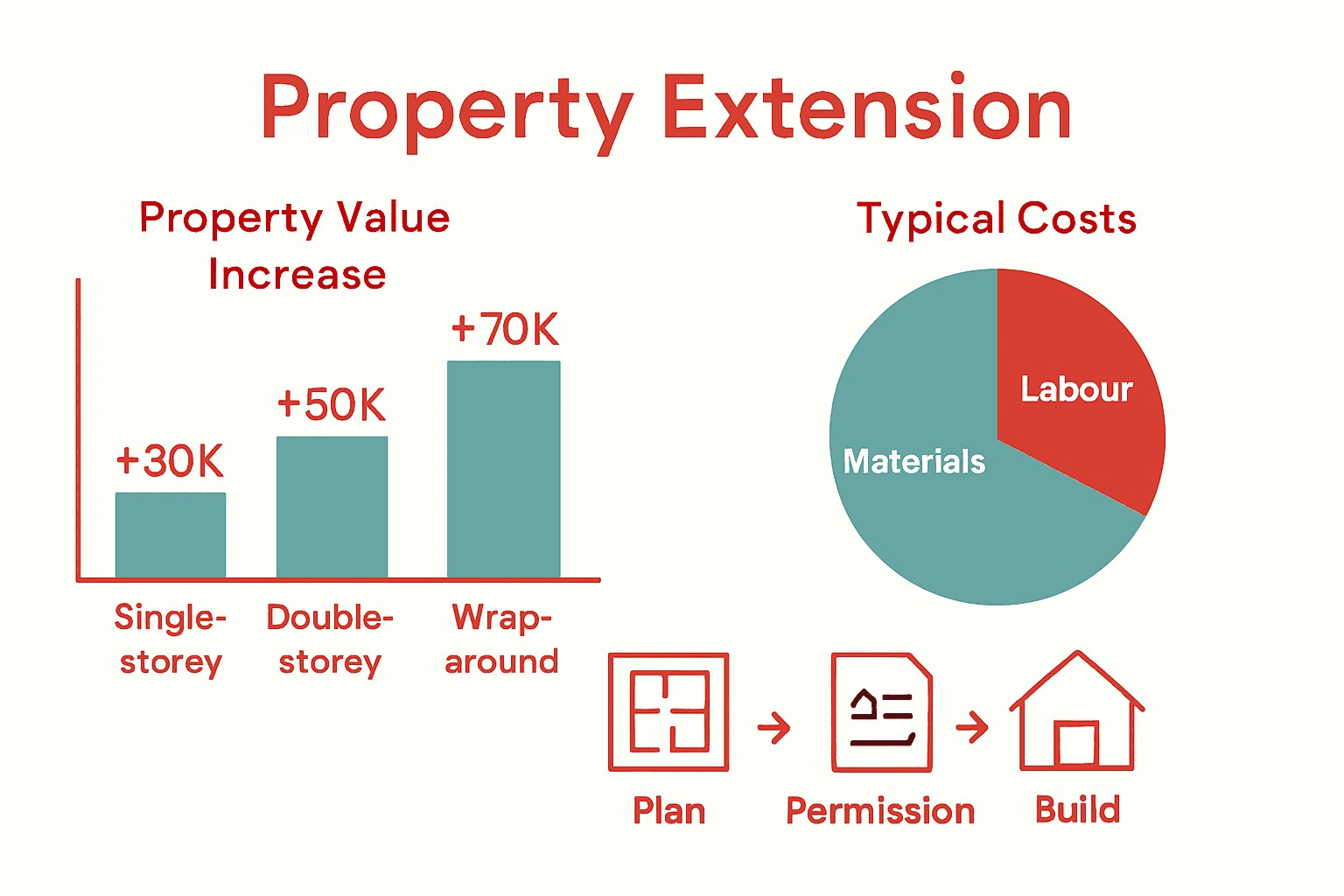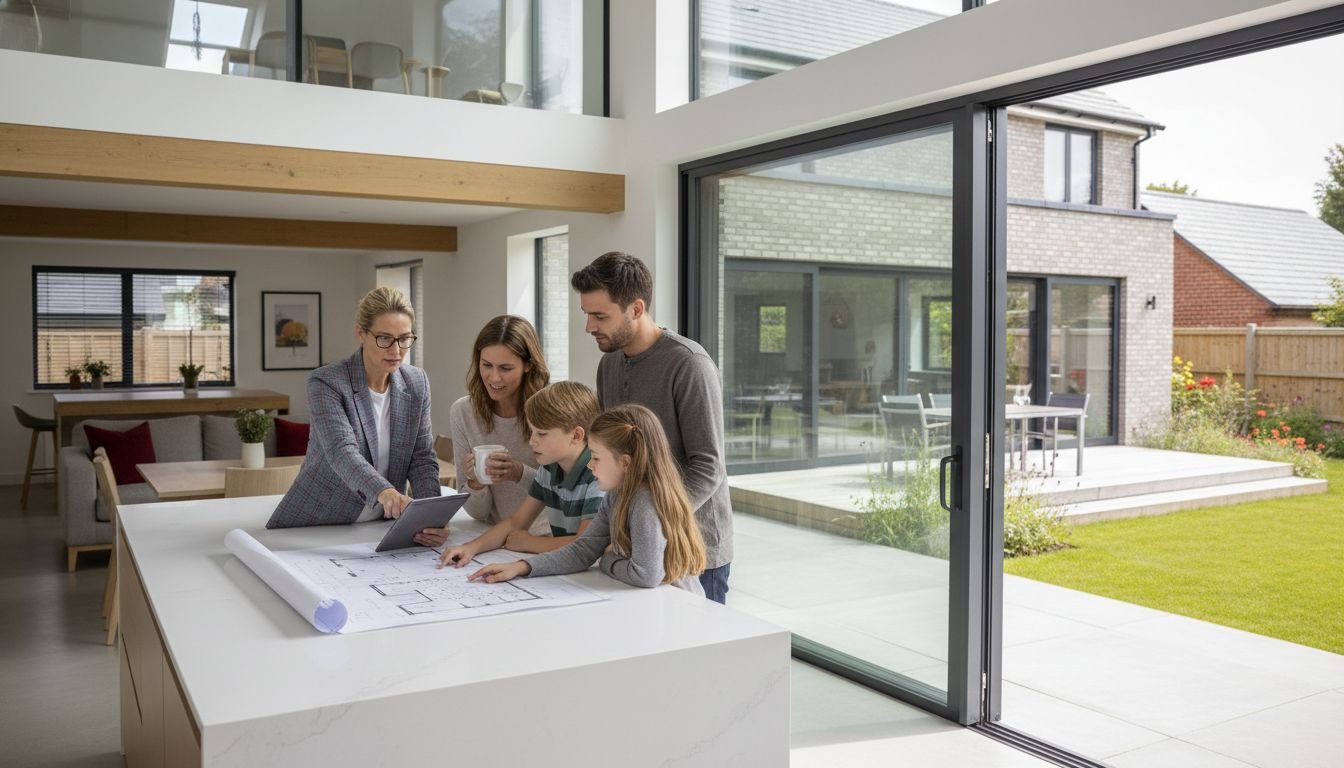Over 40% of UK homeowners consider expanding their living space each year, drawn by the promise of greater comfort and rising property values. Home extensions have become a popular solution for those looking to customise their environment without the stress or cost of moving. With so many options and potential benefits, understanding the real value and essential planning steps behind these projects helps you make informed decisions for your home’s future.
Table of Contents
- Defining Home Extensions And Core Benefits
- Major Types Of Home Extensions Explained
- Planning Permission And UK Legal Framework
- Financial Returns And Impact On Property Value
- Key Risks, Costs, And Common Mistakes To Avoid
Key Takeaways
| Point | Details |
|---|---|
| Home Extensions Offer Value | Well-planned extensions can increase property market value by 10-20%, making them a strategic investment. |
| Understanding Types is Crucial | Selecting the right extension type requires consideration of property layout, budget, and household needs. |
| Navigate Legal Frameworks | Homeowners should familiarize themselves with UK legal requirements to avoid planning complications and delays. |
| Plan Financially | Developing a comprehensive budget with contingencies can help mitigate risks and ensure project success. |
Defining Home Extensions and Core Benefits
A home extension represents a strategic home improvement project that transforms living spaces by physically expanding your property’s existing footprint. According to Homebuilding, home extensions involve creating additional living space that enhances both functionality and property value. These renovations are more than just construction projects they’re intelligent investments in your home’s future.
Typically, home extensions come in several core variations, each offering unique advantages:
- Single-storey extensions: Ground level additions perfect for expanding kitchen or living areas
- Double-storey extensions: Vertical expansions providing significant extra space across two levels
- Wrap-around extensions: Comprehensive designs that maximize available building potential
The primary motivation behind most home extensions is addressing evolving lifestyle needs without the complexity and expense of relocating. By strategically expanding your current property, you can create tailored spaces that adapt to changing family dynamics, work requirements, or personal preferences. Reltic Extend’s guide on understanding home extensions provides deeper insights into how these projects can dramatically improve your living environment.
Beyond immediate spatial benefits, home extensions represent a savvy financial strategy. Property experts consistently demonstrate that well-executed extensions can increase home market value by 10-20%, offering significant return on investment. The key lies in thoughtful design that seamlessly integrates new spaces with existing architectural elements, ensuring both aesthetic appeal and functional enhancement.
Major Types of Home Extensions Explained
Understanding the diverse landscape of home extensions is crucial for homeowners looking to maximise their property’s potential. Homebuilding highlights that home extensions come in several primary configurations, each designed to address specific spatial and architectural needs.
The main types of home extensions include:
Single-storey extensions: Ideal for ground-level expansions, these extensions typically transform kitchen, dining, or living areas by adding horizontal space. Perfect for homes with limited vertical expansion opportunities.
Double-storey extensions: These comprehensive additions provide substantial space across two levels, allowing significant room for bedrooms, bathrooms, or home offices while dramatically increasing property value.
Side return extensions: A clever solution for terraced or narrow properties, these extensions utilise the often-underused side alleyway to create additional interior space without compromising garden areas.
Wrap-around extensions: These innovative designs combine side return and rear extensions, creating an L-shaped space that maximises available building potential and transforms home layouts.
Loft conversions: While technically not a traditional extension, loft conversions transform unused attic spaces into functional living areas, offering an alternative approach to home expansion.
For homeowners seeking more detailed insights, our comprehensive guide on understanding extension types provides in-depth exploration of each extension style.
Choosing the right type depends on multiple factors including property layout, budget, local planning regulations, and specific household requirements.
Each extension type offers unique advantages, transforming not just square footage but potentially revolutionising how you experience and utilise your living space.
 Thoughtful planning and professional design can turn these structural additions into remarkable home improvements that enhance both functionality and aesthetic appeal.
Thoughtful planning and professional design can turn these structural additions into remarkable home improvements that enhance both functionality and aesthetic appeal.
Planning Permission and UK Legal Framework
Navigating the complex landscape of home extensions requires a thorough understanding of the UK’s legal requirements. Gov.uk provides crucial insights into permitted development rights, which allow homeowners to undertake certain extensions without formal planning permission, subject to specific criteria.
Key considerations for permitted development include:
- Size limitations: Extensions must typically remain within designated dimensional boundaries
- Location restrictions: Proximity to property boundaries and existing structures matters
- Height specifications: Different rules apply for single and double-storey extensions
- Materials and appearance: Must complement existing property design
Torfaen’s building regulations guidance emphasises that beyond planning permission, home extensions must meet stringent building regulation standards. These regulations ensure structural integrity, fire safety, and energy efficiency, protecting both homeowners and future occupants.
While permitted development rights offer flexibility, exceeding specified limits requires formal planning approval. This process involves submitting detailed plans to local authorities, who assess the extension’s impact on neighbourhood character, structural safety, and potential disruption to neighbouring properties. Our comprehensive guide on understanding the house extension approval process provides deeper insights into navigating these complex requirements.
Successful home extensions demand meticulous planning and a comprehensive understanding of legal frameworks. Homeowners should consult local planning departments, consider professional architectural advice, and carefully review all regulatory requirements before commencing their extension project. The effort invested in understanding these regulations can save significant time, money, and potential legal complications in the long run.
Financial Returns and Impact on Property Value
Home extensions represent far more than additional square footage they’re strategic financial investments that can significantly enhance property value and generate substantial economic returns. While specific percentage increases vary, well-designed extensions consistently prove to be smart financial decisions for homeowners looking to maximize their property’s potential.
Key financial benefits of home extensions include:
- Immediate value appreciation: Extensions typically increase property market value by 10-20%
- Cost-effective alternative to moving: Often substantially cheaper than purchasing a larger property
- Customised living space: Tailored improvements that reflect personal lifestyle needs
- Rental potential: Additional space can create opportunities for rental income or home office setup
Our comprehensive guide on extension design strategies highlights that strategic extensions go beyond mere square footage. The quality of design, materials used, and how seamlessly new spaces integrate with existing structures dramatically influence potential value enhancement. Factors like natural light, functional layout, and aesthetic coherence play crucial roles in determining financial returns.
Financial prudence demands careful planning. Homeowners should consider factors such as local property market trends, neighbourhood comparables, and potential return on investment before commencing an extension project. While most extensions add value, overcapitalising or implementing design choices that don’t align with local market expectations can limit financial benefits. Professional consultation and thorough market research can help ensure your extension becomes a sound financial strategy rather than an unnecessary expense.
Ultimately, home extensions offer a unique opportunity to simultaneously improve living conditions and build long-term financial equity.
 By approaching these projects with strategic insight, homeowners can transform their living spaces into valuable assets that grow in worth over time.
By approaching these projects with strategic insight, homeowners can transform their living spaces into valuable assets that grow in worth over time.
Key Risks, Costs, and Common Mistakes to Avoid
Home extensions represent significant financial and logistical investments that require meticulous planning and strategic decision-making. Budget overruns and unexpected complications can quickly transform an exciting renovation project into a financially draining nightmare if homeowners aren’t properly prepared.
Common risks and potential pitfalls include:
- Hidden structural challenges: Unexpected foundation or structural issues can dramatically increase project costs
- Planning permission delays: Regulatory complications can stall projects for months
- Contractor reliability: Choosing inexperienced or unreliable builders can lead to substandard work
- Budget miscalculations: Initial estimates often fail to account for comprehensive project expenses
- Design incompatibility: Extensions that don’t harmonise with existing property architecture
Our comprehensive guide on understanding house extension approval processes emphasises the critical importance of thorough pre-planning. Successful extensions demand comprehensive budgeting that includes not just construction costs, but also potential contingency funds, professional fees, and potential temporary relocation expenses.
Financial prudence requires a multifaceted approach. Homeowners should obtain multiple professional quotes, create detailed project specifications, and establish clear contractual agreements that outline precise scope, timeline, and payment structures. Building a 20-25% contingency fund into your budget can provide critical financial flexibility, protecting against unexpected expenses that frequently arise during complex home improvement projects.
Ultimately, the key to mitigating risks lies in comprehensive research, professional consultation, and maintaining realistic expectations. By understanding potential challenges in advance, homeowners can approach extensions as calculated investments rather than speculative ventures, maximising both financial returns and personal satisfaction with their home improvement journey.
Transform Your Home with Expert Extension Solutions
If you are seeking to expand your living space while increasing your property’s value, you understand how important it is to get your home extension right. Common challenges like navigating planning permissions, avoiding costly design mistakes, and managing budgets can feel overwhelming. With over 20 years of experience in bespoke residential extensions across London and Surrey, we specialise in helping homeowners tackle these hurdles confidently and successfully.
Explore how thoughtful design and clear cost planning can make all the difference by visiting our Cost & Value of Home Extensions | Reltic Extend page. Get inspired by modern, functional ideas tailored for contemporary living on our Lifestyle & Home Ideas for Modern Living | Reltic Extend category. Ready to bring your project to life with trusted guidance from start to finish? Contact us today and let our expert team help you create a seamless, stylish home extension that meets your goals and respects your budget at Reltic Extend Contact.
Take the first step now to avoid delays and unexpected costs by partnering with specialists who prioritise quality, compliance, and customer satisfaction every step of the way.
Frequently Asked Questions
What are the main benefits of investing in home extensions?
Home extensions provide additional living space, enhance property value by 10-20%, and can be a cost-effective alternative to moving. They allow homeowners to tailor spaces to their evolving lifestyle needs without the stress of relocation.
What types of home extensions are common?
Common types of home extensions include single-storey extensions, double-storey extensions, side return extensions, wrap-around extensions, and loft conversions. Each type serves different spatial needs and enhances the home’s functionality.
Do I need planning permission for home extensions?
Not always. Many home extensions fall under permitted development rights, which do not require formal planning permission. However, there are specific criteria regarding size, location, and height that must be adhered to, so it’s essential to check local regulations.
How can I ensure a good return on investment with my home extension?
To ensure a positive return, it’s important to focus on quality design and seamless integration with the existing structure. Researching local property trends, avoiding overcapitalization, and consulting professionals can help maximize the financial benefits of your extension.





